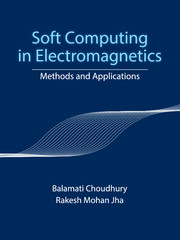Book contents
- Frontmatter
- Dedication
- Contents
- List of Figures
- List of Tables
- Preface
- Acknowledgments
- Abbreviations
- Symbols
- 1 Introduction
- 2 Soft Computing Techniques
- 3 Soft Computing in Electromagnetics: A Review
- 4 Bacterial Foraging Optimization For Metamaterial Antennas
- 5 PSO for Radar Absorbers
- 6 Characterization of Planar Transmission Lines Using ANN
- 7 Fault Detection in Antenna Arrays
- 8 Multi-Objective Particle Swarm Optimization for Active Terahertz Devices
- 9 Soft Computing based CAD Packages for EM Applications
- Author Index
- Subject Index
- References
2 - Soft Computing Techniques
Published online by Cambridge University Press: 05 July 2016
- Frontmatter
- Dedication
- Contents
- List of Figures
- List of Tables
- Preface
- Acknowledgments
- Abbreviations
- Symbols
- 1 Introduction
- 2 Soft Computing Techniques
- 3 Soft Computing in Electromagnetics: A Review
- 4 Bacterial Foraging Optimization For Metamaterial Antennas
- 5 PSO for Radar Absorbers
- 6 Characterization of Planar Transmission Lines Using ANN
- 7 Fault Detection in Antenna Arrays
- 8 Multi-Objective Particle Swarm Optimization for Active Terahertz Devices
- 9 Soft Computing based CAD Packages for EM Applications
- Author Index
- Subject Index
- References
Summary
Soft computing is defined as a group of computational techniques based on artificial intelligence (human like decision) and natural selection that provides quick and cost effective solution to very complex problems for which analytical (hard computing) formulations do not exist. The term soft computing was coined by Zadeh [Zadeh, 1992]. Soft computing aims at finding precise approximation, which gives a robust, computationally efficient and cost effective solution saving the computational time. Most of these techniques are basically enthused on biological inspired phenomena and societal behavioural patterns. The advent of soft computing into the computing world was marked by research in machine learning, probabilistic reasoning, artificial neural networks (ANN), fuzzy logic [Jang et al., 1997] and genetic algorithm (GA). Today, the purview of soft computing has been extended to include swarm intelligence and foraging behaviours of biological populations in algorithms like the particle swarm optimization (PSO) and bacterial foraging algorithm (BFO) [Holland, 1975; Kennedy and Eberhart, 1995; Passino, 2002].
Soft computing methods are associated with certain distinctive advantages. These include the following:
• Since Soft computing methods do not call for wide-ranging mathematical formulation pertaining to the problem, the need for explicit knowledge in a particular domain can be reduced.
• These tools can handle multiple variables simultaneously.
• For optimization problems, the solutions can be prevented from falling into local minima by using global optimization strategies.
• These techniques are mostly cost effective.
• Dependency on expensive traditional simulations packages can be reduced to some degree by efficient hybridization of soft computing methods.
• These methods are generally adaptive in nature and are scalable.
Of late, soft computing techniques have attracted recognition amongst researchers of various branches of engineering in order to arrive at solutions to problem statements [Patnaik and Mishra, 2000; Patnaik et al., 2005; Samii, 2006; Choudhury et al., 2012]. The sturdiness of the above techniques has been well tested pertaining to various problems encountered in every sphere of engineering. Indeed, the last decade has seen the implementation of soft computing in microwave applications. This chapter gives a glimpse of the various soft computing techniques that are widely used in the field of electromagnetics.
Artificial Neural Networks
Certain features of human brain such as the capability to recognize and perceive, have been studied for decades. The remarkable characteristics of the human brain drove researchers into attempting to emulate these characteristics in computers.
- Type
- Chapter
- Information
- Soft Computing in ElectromagneticsMethods and Applications, pp. 9 - 44Publisher: Cambridge University PressPrint publication year: 2016
References
- 6
- Cited by



